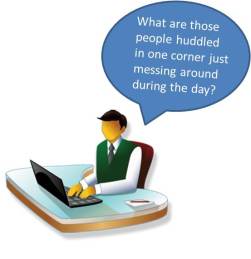I have been struggling lately with the value of blogging–not everyone, just me. There is so much out there already that I have justified my reluctance with many good reasons (or excuses maybe). See what you think of these:
1) How can people wade through the thousands of blogs on topics related to the Toyota Production System (TPS) to find my one small voice?
2) What do I have to say that is unique in the world of continuous improvement?
3) I am not a promoter of me, so I don’t know how people would even know that what I share comes from any unique experience?
4) As the professional me developed, my mentors encouraged humility, self-reflection, responsibility to play a position for the organization vs. a personal role for career development
…and the list goes on. These concepts connected with me and now I see blogging as an activity that goes against my grain. Right?
As I consider my so-called reasons they do look more like excuses–if I consider the intent of blogging. There are probably as many reasons for blogging as there are bloggers. But, I think I have finally found the reason that might get me to post to my blog on a more regular basis (as my boss has so kindly requested).
First, I have been lucky to learn the Toyota Production System from mentors who worked with Mr. Ohno, the official developer of TPS. As I have learned-by-doing from them I see that TPS is unique. These mentors took their time, energy and a bit of their own sanity to pass some level of competency to me. It is my responsibility to do the same. Often when I feel that my sanity is a bit touch-and-go on a project, I am reminded of my duty and passion to pay-it-forward.
Second, I learned an important lesson from one of my early mentors while I was working at the Toyota Supplier Support System (TSSC) that sticks with me today. After leading a workshop with top executives, I was visibly disappointed. I didn’t like my boss to see me like that because I felt he deserved managers who could stand up to the challenges of helping others see the light (not much humility there). Nonetheless there I was with my private pain when he appeared. He often stopped by for casual conversation at the end of the day, but I think this time was telepathic.
We reflected about the workshop. It took approximately 95 seconds for him to ask if I felt that we had been successful. I looked at him as if he had 3 heads and told him NO. His next question was why. Well, I thought, he is a smart person so what is he trying to get me to discover.
I searched my mind-vault and came up with the first thing I saw; a group of leaders who weren’t convinced that TPS would work for them. After sharing this with my boss, he shook his head politely and asked the next question; “How many people out of 25 did you expect to be convinced through this experience?” His question stumped me but I finally came out with a rough guess of 10. He looked surprised so I asked him the same question and his answer was 1. I couldn’t believe it. Why would we put so much time and energy into a workshop if we only expected 1 conversion? He explained that people who are “convinced” in a workshop are either miraculously in the right place at the right time or their epiphany won’t stand up beyond the enthusiasm of the training experience.
I still didn’t get it. Why all the effort? He patiently explained that if we really do convince 1 top leader, that means that all the people in the company will benefit. He asked if that was enough benefit for me and I responded, “of course”. He looked at me with yet another challenge in his eyes and shared that the 1 audience member was not even the whole, real reason we invested our energy. What in the world could it be? “You” he said, “the development of you and our team”.
Okay, humility aside, I have had unique mentors and experiences. I continue to have them now. So, I have decided to blog on, with my one, small voice. I will hope each time to reach at least one person who is hungry to learn what I have to share.
Lesa Nichols
June 19, 2013











